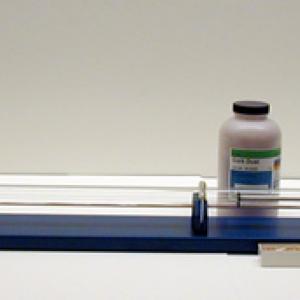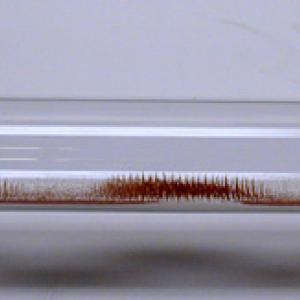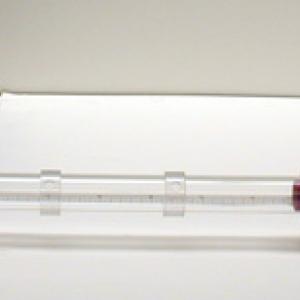College of Liberal Arts & Sciences
3D30.60 - Kundt's Tube
The easiest way to use the glass Kundt's tube is to use it in conjuction with the horn driver. The horn driver can be connected directly to the PASCO function generator. All you need do then is turn up the amplitude knob to just over 1/2 of maximum. This tube resonates very well at 2008 Hz. It takes less than 10 seconds for clear patterns to be produced.
Place a small amount of Lycopodium powder or cork dust into the glass Kundt's tube and spread it the length of the tube. Insert the metal plunger part way into the glass tube and clamp firmly. Stroke the metal plunger near the clamped point with either the bow and rosin, the leather and rosin, or probably the easiest is the chamois and alcohol. The powder should collect in the nodes.
It may be easier to use in class and less messy to use the tubes that already have a speaker on one end and a microphone on the end of the plunger. Note that you can also measure the speed of sound with these tubes by setting the oscilloscope to view Lissajous figures.
- Pangratios Papacosta and Nathan Linscheid, "An Inexpensive and Versatile Version of Kundt's Tube for Measuring the Speed of Sound in Air", TPT, Vol. 54, #1, Jan. 2016, p. 50.
- Norihiro Sugimoto (Stray Cats), "Demonstration of Simple and Dramatic Resonance in a Whiskey Bottle", TPT, Vol. 51, #1, Jan. 2013, p. 58.
- Robert P. Barrett, "Kundt's Tube and an Air Track Blower", TPT, Vol. 18, #7, Oct. 1980, p. 542, reprinted in TPT, Vol. 39, #9, Dec. 2001, p. 552.
- Russell B. Hastings, "Kundt's Tube Improved", TPT, Vol. 23, #5, May 1985, p. 260.
- Robert P. Barrett, "The Mysterious Ridges", TPT, Vol. 19, #4, Apr. 1981, p. 218.
- Robert P. Barrett, "Kundt's Tube and an Air Track Blower", TPT, Vol. 18, #7, Oct. 1980, p. 542.
- John G. McCaslin, "Minimizing Glass Breakage", TPT, Vol. 18, #3, Mar. 1980, p. 231.
- George Kotynek, "Repairing Leaky Ripple Tanks", TPT, Vol. 5, #5, May 1967, p. 243.
- Herbert H. Gottlieb and The AAPT Committee on Apparatus, "Standing Waves in a Glass Cylinder", TPT, Vol. 5, #5, May 1967, p. 242.
- Kenneth Geo. Keith, "Demonstration Experiment to Slow the Effect of Pressure Variation on the Velocity of Sound in a Gas", TPT, Vol. 3, #1, Jan. 1965, p. 30.
- R. B. Hastings, "Thermistor Explorations in a Kundt Tube", AJP, Vol. 37, #7, July 1969, p. 709.
- Freier and Anderson, "Sa-17, 18", A Demonstration Handbook for Physics.
- Richard Manliffe Sutton, "S-128", Demonstration Experiments in Physics.
- Wallace A. Hilton, "S- 3f", Physics Demonstration Experiments.
- R. W. Pohl, Physical Principles of Mechanics and Acoustics, p. 251.
- Ron Hipschman, "Visible Effects of the Invisible", Exploratorium Cookbook III, 190.1 - 190.4.
- Jearl Walker, "1.47: Piles and Ripples of a Kundt Tube", The Flying Circus of Physics with Answers.
- D. Colson, C. J. Lapp, J. A. Eldridge, "Experiment XXXI", 1936 Univ. of Iowa Physics Laboratory Manual, p. 38.
Disclaimer: These demonstrations are provided only for illustrative use by persons affiliated with The University of Iowa and only under the direction of a trained instructor or physicist. The University of Iowa is not responsible for demonstrations performed by those using their own equipment or who choose to use this reference material for their own purpose. The demonstrations included here are within the public domain and can be found in materials contained in libraries, bookstores, and through electronic sources. Performing all or any portion of any of these demonstrations, with or without revisions not depicted here entails inherent risks. These risks include, without limitation, bodily injury (and possibly death), including risks to health that may be temporary or permanent and that may exacerbate a pre-existing medical condition; and property loss or damage. Anyone performing any part of these demonstrations, even with revisions, knowingly and voluntarily assumes all risks associated with them.


